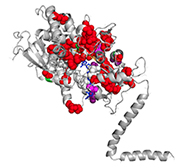Congratulations to A/Prof Brian Monk of the SJWRI's Molecular Microbiology research programme on the award of a three-year Project Grant worth $1,199,967 in the 2019 Health Research Council of New Zealand annual funding round, for his project 'Readying next-generation antifungals for drug development'. This continues a long-standing programme of Marsden Fund and HRC-supported research into antifungal drug development in A/Prof Monk's laboratory. A/Prof Monk says, "The research will use our structure-based understanding of how existing antifungals work in order to create new broad-spectrum drugs that are more effective and inexpensive."
The project
Opportunistic invasive fungal infections (IFIs) carry high morbidity and mortality for those with co-morbidities, especially the immunocompromised, such as transplant and AIDS patients. Despite treatment with the best available antifungal drugs, approximately 50% of the patients with IFIs die. The need for new, potent and inexpensive fungicides is urgent due to innate and acquired resistance to antifungal agents. This project will meet this need. It will use high-resolution structures of the antifungal target lanosterol 14α-demethylase (LDM) from a range of fungal species and humans, together with yeast-based assays, clinical isolates of fungal pathogens, and animal trials, to elucidate key features conferring antifungal specificity and that optimize broad-spectrum antifungal candidates in readiness for drug development by the pharmaceutical industry. Drug resistance will be addressed using in-house technology to identify LDM-directed fungicides and mixtures that improve potency and avoid the emergence of drug target- and drug efflux-mediated antifungal resistance.
The team
Otago-based members of the project team include Dr Mikhail Keniya and Dr Rajni Wilson of the SJWRI's Molecular Microbiology discipline, along with Associate Professor Joel Tyndall of the School of Pharmacy. They were all key investigators on A/Prof Monk's previous HRC-funded work on this project. Two PhD students will work on elements of the project. Yasmeen Ruma and Parham Hosseini will use a yeast expression system to obtain crystal structures that will increase understanding of LDMs from particular species of fungal pathogens.
Team members from overseas include long-term collaborators Dr Anette Klinger and Dr Edmund Fleischer of German company MicroCombiChem, Associate Professor Michaela Lackner of the Medical University of Innsbruck in Austria, and Professor David Perlin, founding Chief Scientific Officer of the new Hackensack Meridian Health Center for Discovery and Innovation in New Jersey, USA. Professor Perlin's expertise lies in drug discovery, mechanisms of antifungal drug resistance and diagnosis of drug-resistant pathogens. He was recently awarded $33.3M USD over five years from the National Institutes of Health to develop new antibiotics to overcome deadly bacteria in hospitals that have become resistant to current treatments. A/Prof Lackner is an early-career researcher who recently visited the Monk laboratory for four months as part of a Catalyst Seeding Fund activity that is creating a smart science platform between NZ and Austria with the goal of broad-spectrum antifungal discovery. She was recently awarded an Austrian FWF grant, on which A/Prof Monk was listed as a collaborator, on the characterization of intrinsic azole resistance in mucormycetes, a group of fungal pathogens for which some existing azole drug treatments are ineffective.
Project details and lay summary (HRC website)
Otago receives 'lion's share' of HRC funding (Otago Bulletin)
Overcoming antifungal drug resistance: 2016 HRC success for A/Prof Brian Monk (SJWRI website)
2013 HRC Funding Round success for Dr Brian Monk (SJWRI website)

A/Prof Brian Monk (foreground), with co-investigators A/Prof Joel Tyndall and Dr Mikhail Keniya.

PhD students Yasmeen Ruma and Parham Hosseini discuss recombinant yeast phenotypes with visiting researcher A/Prof Michaela Lackner.

Structure of the fungal metabolic enzyme lanosterol 14α-demethylase.